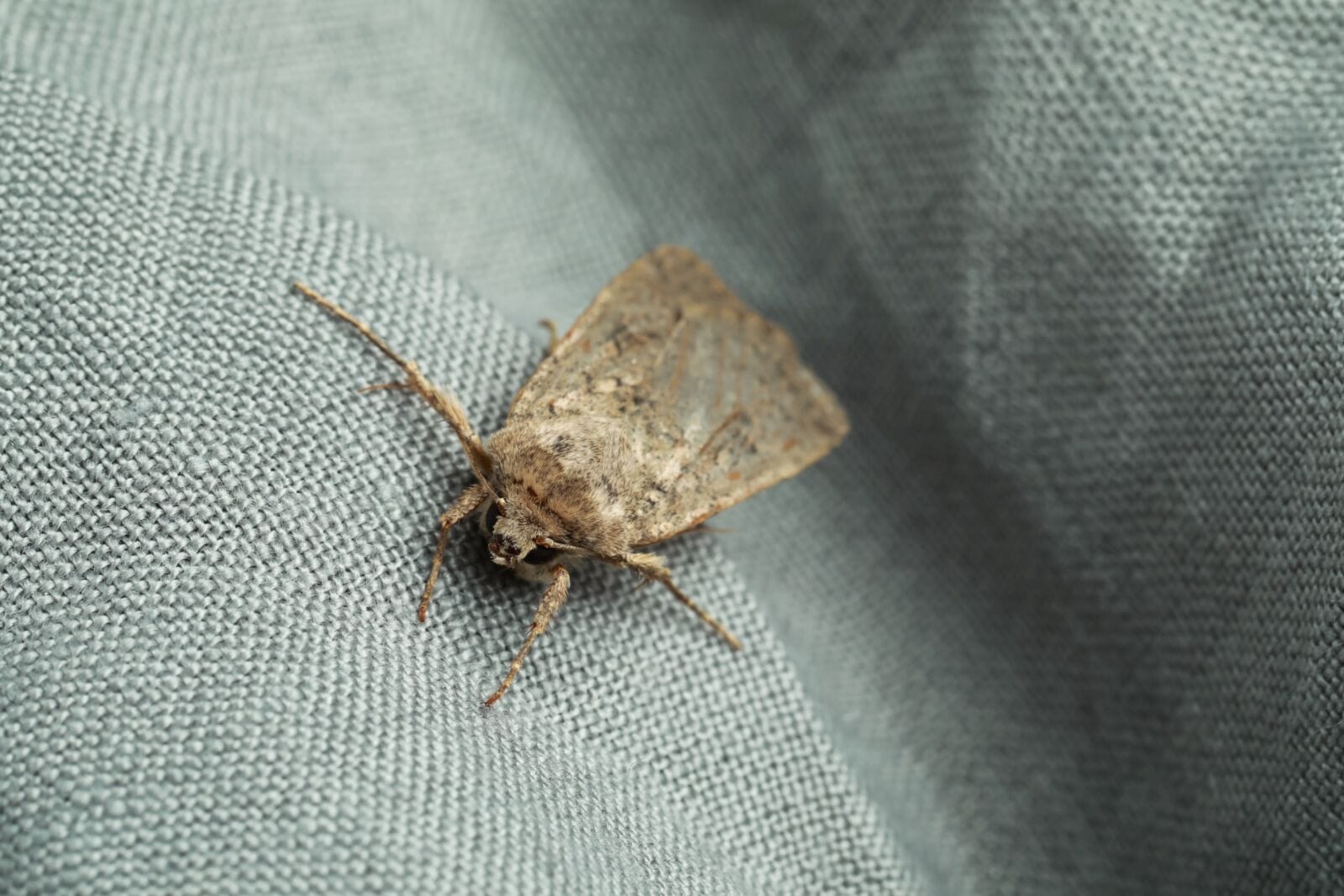Moths may seem like harmless, tiny creatures, but they can cause big trouble in homes and offices. We often overlook these pests, but the damage they can do is extensive and costly, particularly if you’re dealing with a moth infestation. Thankfully, you don’t have to combat these tiny household pests on your own.
We have compiled a comprehensive guide that will provide effective professional solutions to control your moth problem. While there are DIY techniques you can try, nothing replaces the guaranteed service of a professional moth control service naturally.
Types of Moths in Homes
While there are around 160,000 species of moths globally, only a small fraction pose problems for homes. Two types stand out as the most troublesome — clothes moths and pantry moths. The former wreaks havoc by feeding off your clothing made from fabrics like wool and silk, while pantry moths prefer food items stored in your kitchen.
Among clothes moths, the two most common species are the Case-Bearing Clothes Moth and the Webbing Clothes Moth. These pests are not attracted to light and their larvae seek dark, undisturbed places where they can feed on your clothes.
Pantry moths include Indian Meal Moths and Mediterranean Flour Moths which feed on grains and dried foods.
No matter the species, early identification is crucial in ensuring your countermeasures are targeted and effective.
Disruptions Caused By Moths
Moths are more than just a nuisance; their infestation can lead to considerable disruption in your home or even business. For retail businesses selling clothes or food, for instance, such an infestation could mean serious financial implications due to damaged stock.
For home environments, especially if you have family members with allergies, the presence of moths can exacerbate symptoms. Moths shed scales which when airborne, can trigger allergic reactions in some people.
From aesthetic damage like holes in your fine garments, carpets and upholstery to potential health issues, and financial loss – a moth infestation is anything but trivial.
Hence calling for professional pest control services instead DIY can save your time and relieve you from unexpected costs in the long run.
Moth Infestation Signs
A moth infestation may often go unnoticed until either you spot a moth flying around or see the actual damage done. However, there are early signs you can look out for. Tiny white larvae or silken tubes (which are cases for larvae) caught on clothes or in food packages could suggest an infestation.
You might also notice an unusual, musty smell from your clothes or pantry. Stains on fabrics, discarded wings, as well as sporadic holes in clothes and upholstery are all telltale signs of these pests.
Finding flocks of moths or larvae around light fixtures is another clear sign that there are more hidden in darker places.
If you catch such signs on time and call a PCM (Professional Control Management) quickly, it could potentially save hundreds or even thousands of dollars in repairs and replacement costs!
Difference Between Moths and Butterflies
Many people wonder about the difference between moths and butterflies since they look similar and come from the same insect family – Lepidoptera. Despite their similarities, they differ significantly when it comes to color, activity patterns, antennae shape, and wings.
Butterflies are usually more vibrant colored compared to moths, which are generally dull-colored. Butterflies are diurnal, which means they are active during the day while most species of moths are nocturnal – active at night.
Moths have feathery or filamentous antennae while butterflies have smooth antennae with a small ball at the end. Butterfly wings tend to be held vertically over their bodies when at rest, while moths often hold their wings flat.
All these factors can help you distinguish between the two and take necessary measures if you’re dealing with a moth infestation.
Prevention of Moth Infestation
Oftentimes, prevention is better than cure and it’s no different with moths. Keeping your home clean and clutter-free can prevent an infestation. A thorough cleaning of cupboards and wardrobes is recommended periodically.
Avoid storing food or clothes in cardboard boxes as they aren’t immune to infestation. For clothes, consider plastic storage boxes or bags and for food items choose glass jars or airtight plastic containers.
Use lavender or cedar chips as natural deterrents. Moths hate these smells and tend to stay clear of them. Try to wash clothes before packing them away for storage as dirt attracts moths.
By taking these preventive steps along with regular professional pest control check-ups, you can keep your home free from frustrating moth infestations.
Natural Solutions for Moth Control
Why not consider the eco-friendly options available for dealing with a moth infestation? The consideration of natural solutions can still fit to your strategy in dealing with this nuisance. These methods often revolve around naturally repelling these insects, typically using scents that moths find repulsive.
Lavender, eucalyptus, peppermint, and cedarwood are all known moth deterrents, therefore utilizing these in your home as natural repellents is a wise first course of action. Lavender sachets placed in wardrobes and drawers can do wonders. Similarly, cedar chips scattered around susceptible areas or hung in closets can deter moths.
- Essential oils: Moths dislike strong odors and essential oils fit perfectly into this category. Store bought or homemade moth balls made from these oils could be strategically placed in your house to discourage these pests.
- Storing clothes adequately: Besides keeping them clean, ensure that they’re completely dry as moisture can attract moths. Garments not used regularly should be stored within naphthalene balls or natural alternatives like cedar balls or lavender sachets.
Diatomaceous Earth – often shortened to DE – is another natural solution. It’s fine powder made from fossilized aquatic organisms and works by drying out the moths hence causing their death.
Chemical Solutions for Moth Control
In contrast to natural remedies, chemical repellents may offer faster and more comprehensive results. There’s a variety of solutions including sprays, traps and pesticides available on the market to tackle a moth infestation effectively.
- Pesticide Foggers: Also known as “bug bombs”, these products kill moths upon contact. It is important to note however, that foggers require proper safety measures to be taken due to their toxic nature.
- Insecticidal Sprays: These are suitable for short-term moth control. However, they’re usually harsh and can stain fabrics.
- Moth traps: These are widely available, and work using pheromones to attract moths and trap them. They are non-toxic and easy to use.
Always wear protective clothing and follow instructions while using such pesticide products like Pyrethroids – synthetic chemical insecticides that act like pyrethrins, which are derived from chrysanthemum flowers.
Professional Solutions for Moth Control
Sometimes the infestation may be too widespread or severe for home remedies and store-bought solutions. This is where professional solutions come into play. Pest control companies have access to more powerful treatments, and technicians are trained to use them safely.
They will first conduct a survey of your home, identifying the type of moth and the degree of infestation. Tactics used can range from deep cleaning, fumigation through ULV (Ultra Low Volume) Fogging technique to direct insecticide application on breeding hotspots.
A professional service will not just eliminate the existing moths but also their eggs and larvae, something that DIY solutions often miss which could lead to a re-infestation. Moreover, they offer advice on how to prevent future infestations.
While engaging a professional service might seem expensive in the short run, it may prove to be cost effective in the long term, preventing repeat invasions and subsequent damage.
Timing of Moth Infestation Treatments
The best time to handle a moth infestation is undeniably as soon as you notice it. However, there are some tips to consider regarding timing of treatments. Firstly, it’s important to note that moths, being cold blooded creatures, are more active in warmer temperatures. Therefore, early spring or during summer may be a suitable time to initiate pro-active moth control strategies.
If you are using moth traps, keep in mind that they should be used for several months, as one moth can lay up to 400 eggs. Bear in mind also that chemical treatments like fogging or spraying should ideally be done at night when these pests are most active.
Remember, the key to effective extermination lies in early detection and quick action. Swiftly executing treatment plans drastically reduces the risk of significant damage.
Maintenance After Moth Infestation
Post-treatment maintenance is crucial for preventing future infestations. Regularly clean wardrobes and cupboards and ensure careful storage of clothes and food items. Vacuum cleaning curtains, carpets and upholstery can help dislodge any hidden larvae or eggs.
Regular pest control inspections and preventive treatments will not only keep moths at bay but also other pests. It’s recommended to inspect your property frequently and maintain cleanliness across all areas.
Above all, standout practices you can adopt include air drying before storage, meticulous food packaging inspection before purchase, using sealed bags or containers for storage along with usage of natural deterrents like lavender or cedarwood for extra security.
In Summary
There are many ways in dealing with a moth infestation ranging from natural solutions to chemical or professional ones. It is Saliently crucial to stay vigilant and proactive as prevention is always better than cure. Regardless of the size of the infestation, your appropriate actions today could spare you significant expenses and inconveniences tomorrow. Most importantly remember – there’s no shame in calling for professional help when things get out of hand!




